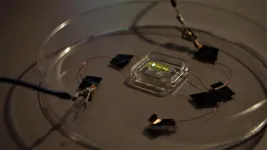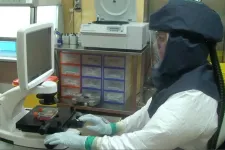(Press-News.org) Scientists at UCL and the IIT -Istituto Italiano di Tecnologia (Italian Institute of Technology) have created a temporary tattoo with light-emitting technology used in TV and smartphone screens, paving the way for a new type of "smart tattoo" with a range of potential uses.
The technology, which uses organic light-emitting diodes (OLEDs), is applied in the same way as water transfer tattoos. That is, the OLEDs are fabricated on to temporary tattoo paper and transferred to a new surface by being pressed on to it and dabbed with water.
The researchers, who described the process in a new paper in the journal Advanced Electronic Materials, say it could be combined with other tattoo electronics to, for instance emit light when an athlete is dehydrated, or when we need to get out of the sun to avoid sunburn. OLEDs could be tattooed on packaging or fruit to signal when a product has passed its expiry date or will soon become inedible, or used for fashion in the form of glowing tattoos.
Professor Franco Cacialli (UCL Physics & Astronomy), senior author of the paper, said: "The tattooable OLEDs that we have demonstrated for the first time can be made at scale and very cheaply. They can be combined with other forms of tattoo electronics for a very wide range of possible uses. These could be for fashion - for instance, providing glowing tattoos and light-emitting fingernails. In sports, they could be combined with a sweat sensor to signal dehydration.
"In healthcare they could emit light when there is a change in a patient's condition - or, if the tattoo was turned the other way into the skin, they could potentially be combined with light-sensitive therapies to target cancer cells, for instance.
"Our proof-of-concept study is the first step. Future challenges will include encapsulating the OLEDs as much as possible to stop them from degrading quickly through contact with air, as well as integrating the device with a battery or supercapacitor."
The OLED device the researchers developed is 2.3 micrometres thick in total (less than one 400th of a millimetre) - about a third of the length of a single red blood cell. It consists of an electroluminescent polymer (a polymer that emits light when an electric field is applied) in between electrodes. An insulating layer is placed in between the electrodes and the commercial tattoo paper.
The light-emitting polymer is 76 nanometres thick (a nanometre is a millionth of a millimetre) and was created using a technique called spin coating, where the polymer is applied to a substrate which is spun at high speed, producing an extremely thin and even layer.
Once they had built the technology, the team applied the tattooable OLEDs, which emitted green light, on to a pane of glass, a plastic bottle, an orange, and paper packaging.
Senior author Professor Virgilio Mattoli, researcher at Italian Institute of Technology said: "Tattoo electronics is a fast-growing field of research. At the Italian Institute of Technology we have previously pioneered electrodes that we have tattooed onto people's skin that can be used to perform diagnostic tests such as electrocardiograms. The advantage of this technology is that it is low-cost, easy to apply and use, and washes off easily with soap and water."
OLEDs were first used in a flatscreen TV 20 years ago. Among the advantages of the technology are that they can be used on flexible, bendy surfaces, and that they can be made from liquid solvents. This means they are printable, providing a cheap way to create bespoke new OLED designs.
INFORMATION:
The investigation of Electron-Positron-Ion (EPI) plasma?--?a fully ionised gas of electrons and positrons that includes astrophysical plasmas like solar winds?--?has attracted a great deal of attention over the last twenty years. A new study published in EPJ D by Garston Tiofack, Faculty of Sciences, University of Marousa, Cameroon, and colleagues, assesses the dynamics of positron acoustic waves (PAWS) in EPI plasmas whilst under the influence of magnetic fields, or magnetoplasmas.
The authors studied the changes in PAWs using a framework of Korteweg-de Vries (KdV) and modified Korteweg-de Vries (mKdV) equations finding a former led to compressive positron acoustic solitary waves (PASWs), whilst the latter resulted in the same and additional rarefactive ...
The total amount of data generated worldwide is expected to reach 175 ZB (Zettabytes; 1 ZB equals 1 billion Terabytes) by 2025. If 175 ZB were stored on Blu-ray disks, the disk stack would be 23 times the distance to the Moon. We face the urgent need to develop storage technologies that can accommodate this enormous amount of data.
The demand to store ever-increasing volumes of information has resulted in the widespread implementation of data centers for Big Data. These centers consume massive amounts of energy (about 3% of global electricity supply) and rely on magnetization-based ...
IRS refers to the application of insecticide onto the interior walls of houses.
The study, by the Wits Research Institute for Malaria (WRIM) and the London School of Hygiene and Tropical Medicine (LSHTM), was published in The Lancet on 25 February 2021.
Targeted vs blanket Indoor Residual Spraying
Malaria still represents one of the world's largest health crises, particularly on the African continent where 94% of cases and deaths occur (World Health Organization, 2020).
Most countries in southern Africa have set the elimination of malaria within their borders as a policy target.
In ...
Prior to the emergence of new mutants of the coronavirus, such as the British variant B.1.1.7, the SARS-CoV-2 variant named D614G had already mutated from the original SARS-CoV-2 pathogen that triggered the pandemic. D614G has rapidly spread to become the most abundant variant worldwide and this D614G mutation remains in all the new emerging variants. An international team including researchers from Bern has now been able to demonstrate in both the laboratory and in animal models why the D614G variant was able to gain the upper hand over the original SARS-CoV-2 virus. "Our approach ...
A study, led by researchers at the Instituto de Astrofísica de Canarias (IAC) and carried out with OSIRIS, an instrument on the Gran Telescopio Canarias (GTC), has found the most densely populated galaxy cluster in formation in the primitive universe. The researchers predict that this structure, which is at a distance of 12.5 billion light years from us, will have evolved becoming a cluster similar to that of Virgo, a neighbour of the Local Group of galaxies to which the Milky Way belongs. The study is published in the specialized journal Monthly Notices of the Royal Astronomical Society (MNRAS).
Clusters of galaxies are groups of galaxies which remain together because of the action of gravity. To understand the evolution of these "cities of galaxies" scientists look ...
Researchers from the Andalusian Centre for Molecular Biology and Regenerative Medicine (CABIMER), in collaboration with the Swiss Institute for Experimental Cancer Research (ISREC) have studied the mechanisms behind the higher tendency of people with Mulibrey syndrome to develop tumours. Their results point to the important role of the TRIM37 protein, whose absence explains the appearance of tumour cells.
Mulibrey syndrome is a so-called rare disease as it occurs in less than 5 out of every 10,000 inhabitants. Some of these diseases usually have a very definite genetic basis. ...
If light is strongly concentrated in time and space, resulting in extreme photon densities, it can enable interaction with all conceivable materials. By using these ultrashort laser foci, even transparent materials can be modified, even though they ordinarily would not interact. Short, focused laser pulses can overcome this transparency and allow energy to be deposited completely contact-free. The exact response of the material to the radiation can be very diverse, ranging from marginal refractive index changes to destructive microscale explosions that evacuate entire areas.
Using the laser pulses for optical machining allows for equally diverse material modification, such as separating or joining using the same laser system. Due to the extremely short exposure time and low degree ...
Based on a manual recently discovered in a 3,500-year-old medical papyrus, University of Copenhagen Egyptologist Sofie Schiødt has been able to help reconstruct the embalming process used to prepare ancient Egyptians for the afterlife. It is the oldest surviving manual on mummification yet discovered.
In ancient Egypt, embalming was considered a sacred art, and knowledge of the process was the preserve of very few individuals. Most secrets of the art were probably passed on orally from one embalmer to the other, Egyptologists believe, so written evidence is scarce; until recently, only two texts on mummification had been identified.
Egyptologists were therefore surprised to find a short manual on embalming in a medical text that is primarily concerned with ...
"Everyone's unique" is a popular maxim. All people are equal, but there are of course individual differences. This was no different with dinosaurs. A study by researchers at the University of Bonn and the Dinosaur Museum Frick in Switzerland has now revealed that the variability of Plateosaurus trossingensis was much greater than previously assumed. The paleontologists examined a total of 14 complete skulls of this species, eight of which they described for the first time. The results have now been published in the scientific journal "Acta Palaeontologica Polonica".
Plateosaurus lived during the Late Triassic, about 217 to 201 million years ago. "With well over 100 skeletons, some of them completely preserved, ...
The latest developments in fluorescence microscopy make it possible to image individual molecules in cells or molecular complexes with a spatial resolution of up to 20 nanometres. However, under certain circumstances, an effect occurs that falsifies the results: the laser light used can cause very reactive oxygen molecules to form in the sample. These can then damage the fluorescent dyes used to such an extent that they no longer fluoresce. Among microscopy experts, this effect is known as photobleaching.
However, various fluorescent dyes can also be transformed by photobleaching so that they absorb light of shorter wavelengths. "A previously red fluorescent dye then glows green. Its fluorescence ...






